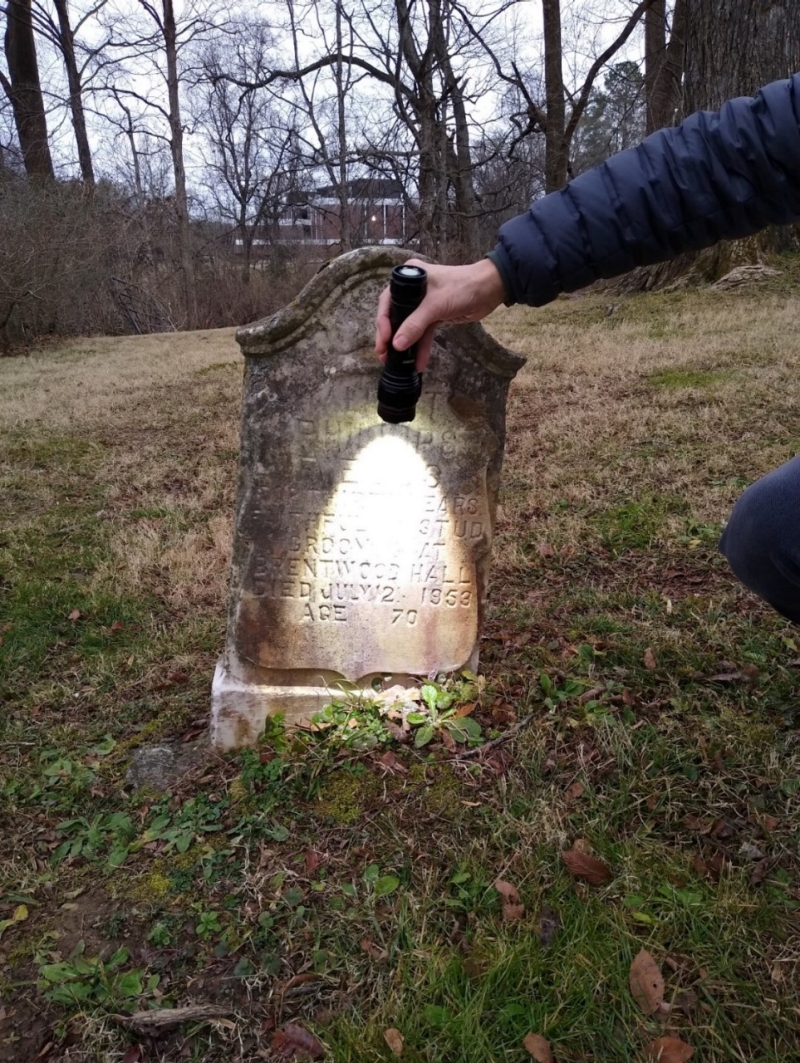Preservation Practices and Other Resources

This headstone from the William Ewing Family Cemetery, Nashville, is remarkably readable with a 1400 Lumen flashlight. Since the stone is not being touched in any way, no damage is done! Photo courtesy of the Tennessee Historical Commission
Headstones and cemetery features are exposed to acid rain, water damage, incorrect cleaning and maintenance techniques, uncontrolled plant growth, and even gravity. To ensure a cemetery’s continued survival:
- When in doubt, do nothing—While a headstone might look like it is in serious need of conservation or preservation, doing nothing is always safer than doing something that might cause lasting damage. If you are unsure of what to do in such a case, contact a professional.
- Always document your work – Before and after documentation--written and photographic--ensures that others will understand what you have already done. Remember, you won’t be around forever, just like the folks in the cemetery you are trying to protect.
- Always have a plan – Be sure to be prepared for your trip to preserve a cemetery. Wear proper attire, carry proper equipment, and walk the grounds. In short, make sure what needs to be done before you accidentally destroy something due to lack of preparation.
- Always contact the cemetery owner – Although descendants have the perpetual right to visit and maintain the family cemetery, it is a good idea to contact any surrounding property owners prior to visitation to avoid confrontation. Also consider reaching out to other descendants so they know what you are doing. They have the same rights you do, and they might even help!
- Use D/2 solution, a soft-bristle brush, and water to clean headstones – This is the current recommend method for cleaning. Watch this video by Jason Church from the National Center for Preservation and Training.
Things you shouldn’t do
- Never pressure wash headstones – High pressure water cleaning always damages headstones even if the damage is not visible and it often leaves unsightly marks. Cleaning by hand using soft bristled brushed, soft plastic spatulas or a low-pressure sprayer is best. The less abrasion used the less the damage. Water is ok for cleaning as is D/2, but do not use over-the-counter cleaning chemicals. They will also cause damage.
- Refrain from string trimming around headstones – Like pressure washing, string trimming can damage the headstone even if the erosion is not apparent. Hand trimming is best. If a string-trimmer is to be used, always use the lightest gauge string available and angle the trimmer head toward the ground to minimize damage. Herbicide use is not recommended.
- Never reset headstones (unless you know what you are doing) – Stones can be deceptively heavy, and there are proper methods for resetting stones. If you know them already, be sure that you have enough volunteers on hand to maneuver stones without hurting yourself. Otherwise, contact a professional.
- Never reattach or patch headstones yourself (unless you know what you are doing) – Contact a professional. There are proper techniques and adhesives used by specialists that minimize damage. Never use cement or other adhesive products from your local hardware store.
- Never cut trees, shrubs, etc. without proper consultation – Interested parties could easily claim this as an act of desecration, which is a Class E Felony under TCA 39-17-311 and/or TCA 39-14-408. In addition, never sell anything including wood products procured from a cemetery listed in property records as 70-Exempt. Such an act could be considered theft of property under TCA 39-14-105 and could be prosecuted as a tax violation unless certain conditions apply. There may be exceptions in cases where interested parties are legally the cemetery's owners. You are highly encouraged to check with our office before any action is taken.
- Never use shaving cream or flour to read a headstone – It is common for people to try applying shaving cream, flour or other foreign substances into carvings to better read the information, but this is never a good idea. Foreign substances such as these cause lasting damage to the stone leading to further deterioration. Use light. Rubbings are also frowned upon for the same reasons.
For more information:
- Archaeological Consultants
- Cemetery Conservators for United Standards
- Distributors – D/2 Biological Solution
Resources
Middle Tennessee State University Center for Historic Preservation
- MTSU Center for Historic Preservation
- MTSU Center for Historic Preservation Cemetery Resources
- MTSU Center for Historic Preservation's Guide to Cemetery Cleaning
National Park Service
Other Helpful Resources
(The Tennessee Historical Commission has provided the information for the following sites for informational use. THC does not officially endorse or recommend any of the following resources.)